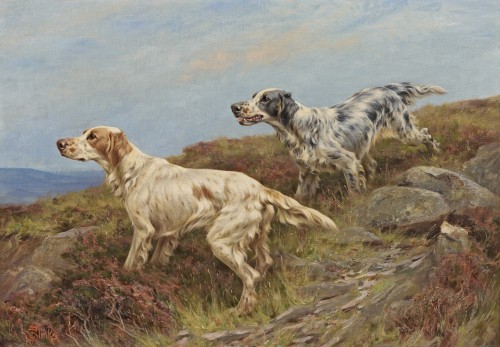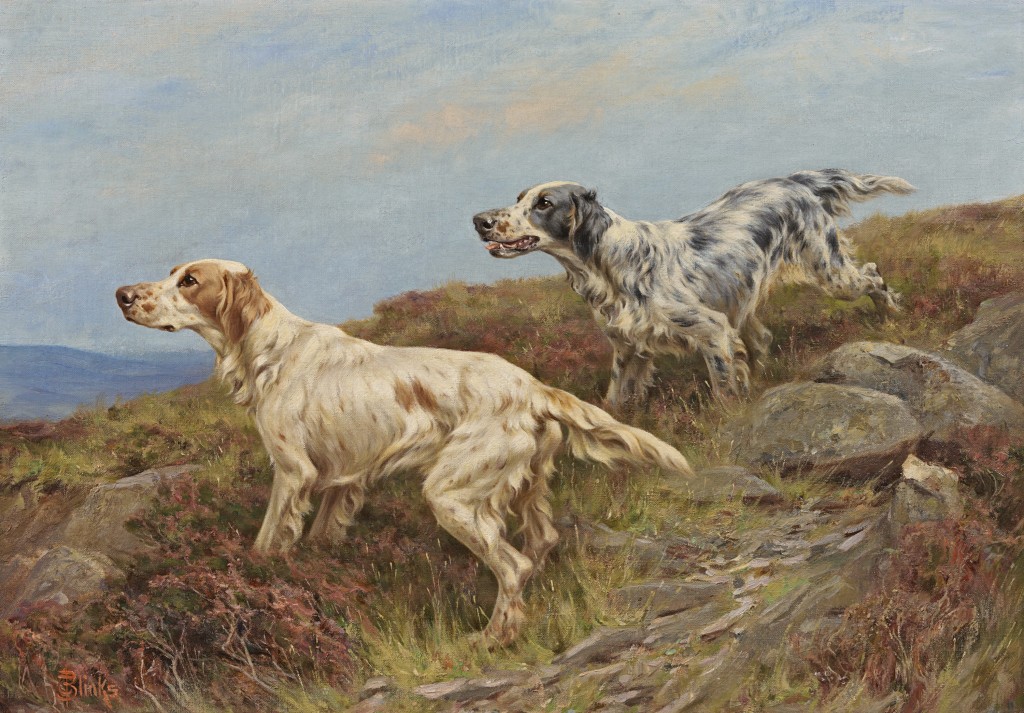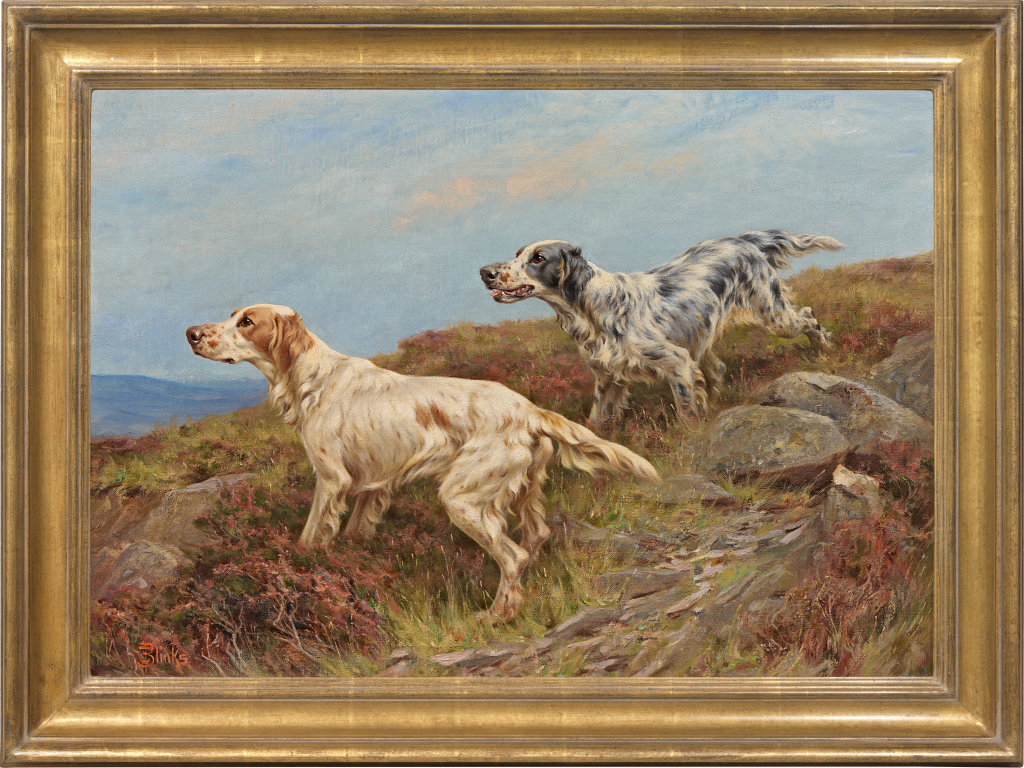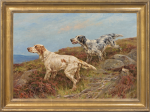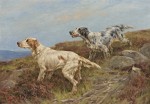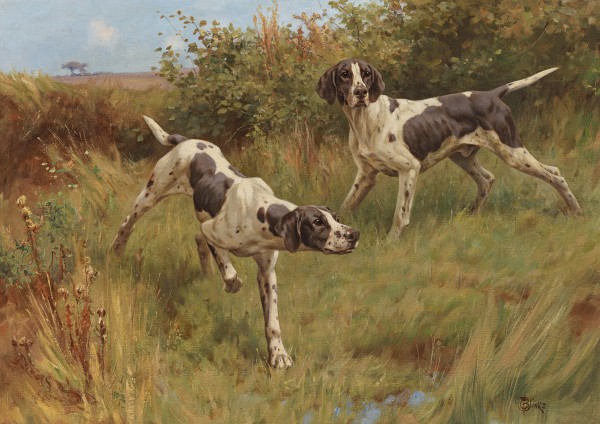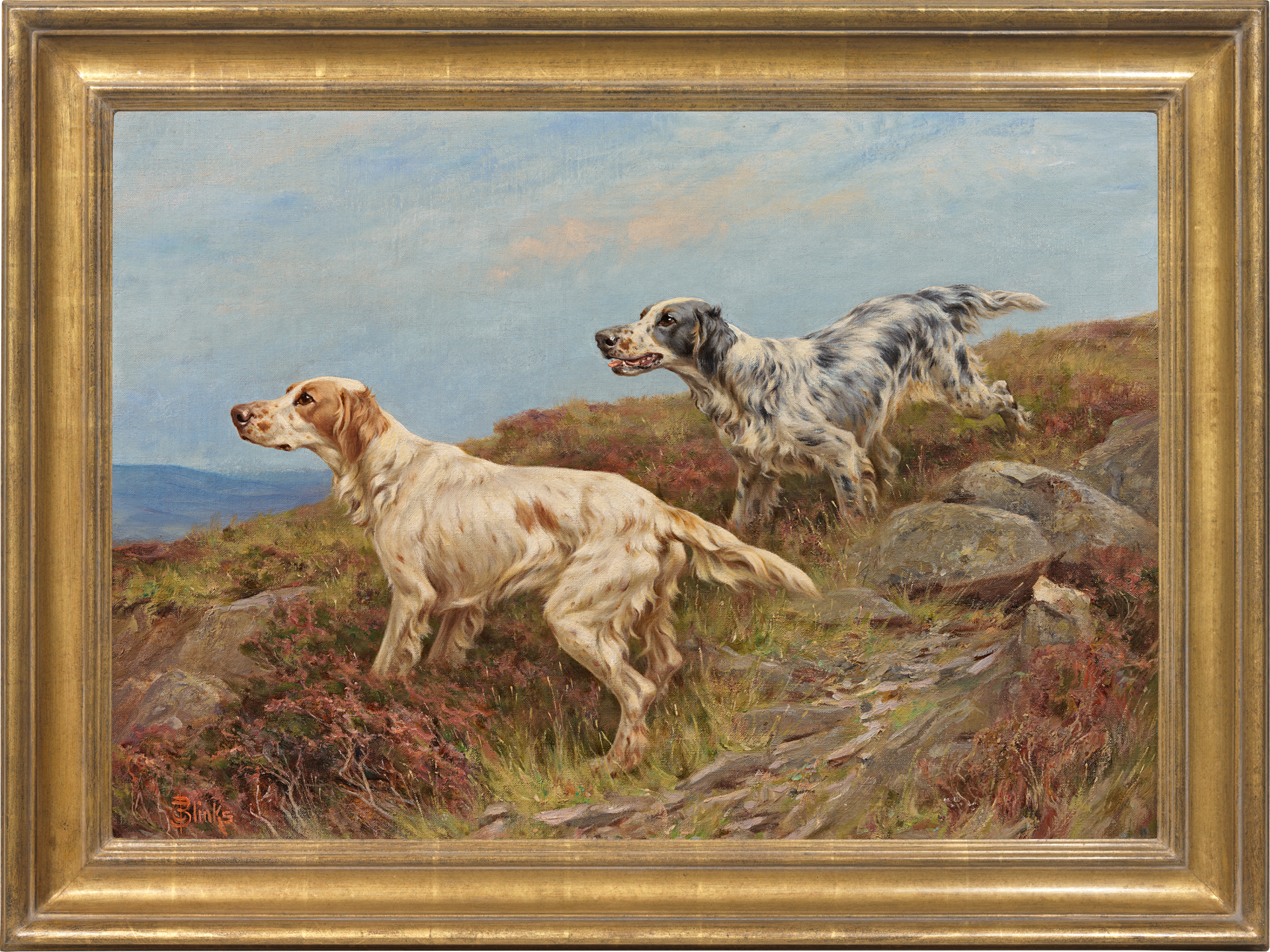THOMAS BLINKS
Maidstone 1853 - 1910 St John's Wood
CC 163/CC 164
Two pointers on the scent
Two English setters in a moorland landscape
Signed
Oil on canvas: 17 x 24 in / 43.2 x 61 cm
Frame size: 22 x 29 in / 55.9 x 73.7 cm
A pair
The former signed lower right: TBlinks;
the latter signed lower left: TBlinks
Provenance:
Commissioned from the artist by John Readhead, Westoe Hall, South Shields, Co. Durham;
by descent in a private collection, UK
Thomas Blinks excelled at paintings of gundogs at work, pointers and setters being particular favourites. The painting of English pointers superbly depicts the tension of the moment as the leading dog points a game bird, with its companion ‘backing’ or acknowledging the point. Alerted to where the bird is hidden, the gun can then walk it up.
The origin of the English pointer is hidden in the mists of history, but the name is thought to derive from the Spanish punta, ‘point’[1]. Spanish pointers appeared in England around 1650 and were used to point hare for greyhounds to course. In the early eighteenth century, when shooting game on the wing became popular, pointers were used almost exclusively to point game birds. A painting of 1725 shows the 2nd Duke of Kingston working with ten of his celebrated black pointers[2]. Spanish pointers were heavy and slow; the breed was enhanced by dogs from Navarre and Italy and at the end of the eighteenth century by English foxhound and greyhound blood. The fanatical sportsman Colonel Thomas Thornton (1757-1823) bred Dash, ‘the Eclipse of Pointers’, whom he sold for £160 worth of champagne and burgundy, a hogshead of claret, an elegant gun, and a pointer[3].
Blinks’s pointers have the sleekness and speed of late nineteenth century dogs, by which time the breed had been further improved by the efforts of such enthusiasts as William Arkwright, author of The Pointer and its Predecessors. Arkwright wrote of the pleasure of shooting over pointers: ‘The chief glory of the sport is to shoot over a brace of racing pointers, matched for speed and style, sweeping over the rough places like swallows and passing each other as if they were fine ladies not introduced’[4].
The pair to this painting depicts two English setters, one orange and white, one white ticked with black, both characteristic of the nineteenth century breed. Setters, like spaniels (hence the name) derived from a type of Spanish hunting dog which is documented as early as 1335. Early sporting writers described them as ‘setting’ or ‘crouching’ spaniels, as opposed to ‘finding’ or ‘springing’ spaniels, which flushed game without pointing it. Dr John Caius, in his Treatise on English Dogs (1576) wrote of the characteristics of the setter: ‘Another sort of Dogges be there, serviceable for fowling, making no noise either with foote or with tounge, whiles they followe the game….When he approacheth neere to the place where the birde is, [the dog] layes him downe, and with a marcke of his pawes, betrayeth the place of the byrdes last abode’[5]. As the setter crouched down, the hunter moved stealthily forward and threw a net over the birds.
In 1624 some working setters were sent to James I by Louis XIII, to be used in conjunction with falcons. From the eighteenth century they were used in a similar way to pointers, to point game which a rough shooter walked up. The two most prominent English setter breeders of the early nineteenth century were Edward Laverack and RL Purcell Llewellin, from whose dogs most pedigree English setters descend[6]. English setters were represented in the first recorded dog show in 1859 and at the first field trial in 1865.
THOMAS BLINKS
Maidstone 1853 - 1910 St John's Wood
Thomas Blinks is best known for his hunting and racing scenes and dog pictures. Despite paternal opposition to his early interest in art, and a fruitless apprenticeship with a tailor, Blinks finally followed his artistic leanings. Although he received no formal training, his understanding of horse anatomy and action were learnt from observation at Tattersalls.
Blinks first exhibited at the Dudley Gallery in 1881, the Royal Society of British Artists in 1882, and regularly at the Royal Academy from 1883 to 1910. His paintings are much admired for his ability to combine accuracy of observation with freedom of brushwork and a polished finish. Blinks was particularly good at conveying the pose and psychology of sporting dogs at work.
The work of Thomas Blinks is represented in the collection of Her Majesty the Queen; Leicester Museum and Art Gallery, and Preston Manor, Brighton.
[1] See William Secord, Dog Painting 1840-1940, Woodbridge 1992, p.149.
[2] See Louise Petrie-Hay, Gundogs: their History, Breeding and Training, London 1987, p.70.
[3] Vero Shaw, The Illustrated Book of the Dog, London 1890, p.396.
[4] Quoted in Petrie Hay, op. cit., p.72.
[5] Quoted in Shaw, op. cit., p.352.
[6] See William Secord, Dog Painting 1840-1940: a Social History of the Dog in Art, Woodbridge 1992, pp.134-148.

